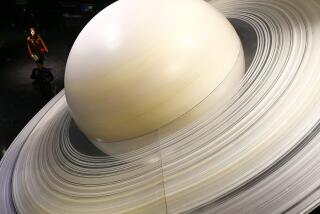Two new solar systems join the cosmic roster
- Share via
Astronomers have found two new solar systems circling distant stars, one with as many as seven planets and both with planets only slightly larger than Earth. The system with seven planets is the largest yet known beyond our own, and the two planets close to the size of Earth are the smallest yet discovered.
Neither could be considered Earth-like, however. Both orbit so close to their stars that their surfaces are blistering hot — so hot that they might even glow, experts said. Nonetheless, their discovery gives researchers hope that it may be possible to discover planets of similar size farther out from stars in the so-called habitable zone, where liquid water can exist on the surface.
The new solar systems were detected using different instruments, one in Chile and one in space, and different techniques. But both illustrate the rapid progress that is being achieved in identifying so-called extrasolar planets, those circling other stars.
The first extrasolar planet was not discovered until 1995, but the number has now burgeoned to 461 as of June. That month, the team responsible for one of this week’s announcements said that it had identified an additional 700 potential extrasolar planets, although those findings must be confirmed.
There are two principal ways to look for such planets. One is to watch for variations in a star’s brightness caused by a planet passing in front of it. That is how NASA’s Kepler orbiting observatory works. It monitors about 150,000 stars in a small segment of the sky, imaging them every 30 minutes to monitor changes in brightness caused by the transit of a planet.
It was the Kepler group that announced 700 new candidate planets in June. On Thursday in the online journal Science Express, it announced the discovery of a system with three planets, including one with a radius only 1.5 times that of Earth. This is the first extrasolar solar system discovered using such transits.
The second technique is to monitor the position of stars carefully to look for wobbles caused by gravitational interaction with their planets. A team using the European Southern Observatory’s 3.6-meter telescope at La Silla, Chile, announced Tuesday at an international symposium in France that it had used the wobble technique to identify a system with at least five planets and probably seven, only one fewer than in Earth’s system.
Using an instrument known as the HARPS spectrograph at the La Silla telescope, the team led by Christophe Lovis of the University of Geneva has spent six years studying a sun-like star called HD 10180, located 127 light-years from Earth in the southern constellation of Hydrus.
The team observed five planets with masses like Neptune, about 13 to 25 times that of Earth. All are within 130 million miles of their star — the Earth is within 93 million miles of the sun — with the closest only 5.5 million miles away. Their orbital periods range from about six to 600 days.
The team also found preliminary evidence for two other planets, one a Saturn-like planet (about 65 Earth masses) orbiting in 2,200 days, and the second one with a radius 1.4 times Earth’s (about three to four times Earth’s mass) orbiting within a period of 1.18 days. Lovis told a news conference that the team is 99% confident the latter two planets are there.
The Kepler group found its solar system surrounding a star now called Kepler-9, about 2,000 light-years from Earth in the constellation Lyra. One of the Saturn-sized planets orbits the star every 19.2 days at a distance of 13 million miles, while the second orbits it every 38.9 days at a distance of 21 million miles. The team was able to use slight variations in the planets’ orbital periods to determine their mass, the first time this has been achieved using the transiting technique.
The small third planet, with a mass 1.5 times that of Earth, orbits about 1.5 days at a distance of 2.5 million miles.
thomas.maugh@latimes.com






